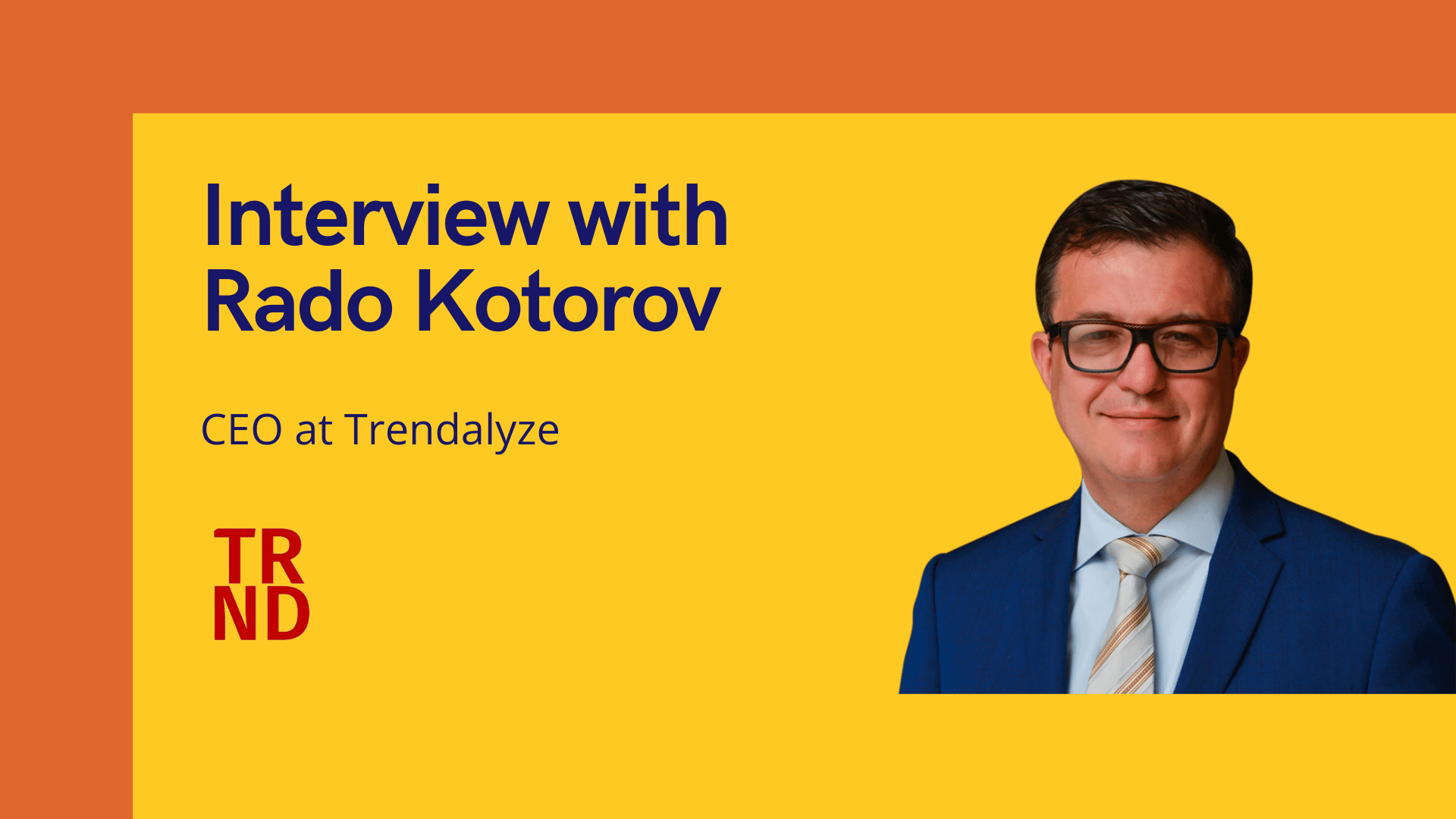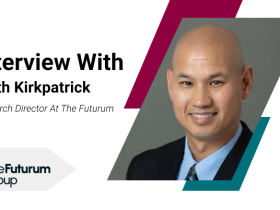Tell us how you came to be the CEO of Trendalyze.
I co-founded Trendalyze Inc. in September 2014. The company was initially registered in London where the other co-founder was based. Initially, I was involved only part-time doing primarily product design as I had a full-time job at Information Builders Inc (a leading Data Management and Business Intelligence company based in New York City). The company was originally funded by R&D grants and angel investors. We moved the company officially to the USA in 2017 when we received our first institutional investment. I was the Chairman of the Board of Trendalyze inc. and my cofounder was the CEO. Trendalyze was trying to solve a very big challenge in a novel way, and it took until 2019 to build and release version 1 of our enterprise-ready highly scalable product. I left Information Builders in January 2019 to become the CEO of Trendalyze. In 2019 I had to take the product through two more battle-tested releases and built the go-to-market team. In January 2020 we officially released Version 3 and started selling at scale.
What are some of the industrial sectors that Trendalyze caters to?
Every company in every industry collects granular time series data. This is because companies are digitizing their entire operations. Digitization means putting sensors and trackers in all operations, machines, and processes. The sensors and trackers generate massive amounts of granular time series data, i.e., data collected on milliseconds, seconds, and minutes intervals. Why do companies collect this data? Because if they can find in it signals, anomalies and patterns, and get early warning signals for them, they can save or make money. Therefore, the Trendalyze platform is applicable across all industries. But not all industries are at the same level of maturity. Manufacturing, finance, automotive, and healthcare lead the pack. This is because there are already a lot of IoT in these industries. If you think, the financial industry pioneered high-frequency trading at milliseconds intervals in 2010.
What are some of the common challenges customers approach Trendalyze with?
Companies collect data for two reasons:
(1) solve business issues, i.e., save costs or make things more efficient
(2) find new opportunities, i.e., new revenue streams, new product features, better segments to sell to, etc. Today they have data, but unless they can extract and act on insights from this data to achieve better bottom-line results, this data is just a sunk cost. And when you have massive amounts of data, it is not humanly possible to get these insights easily. Many companies tried machine and deep learning, but it is costly, and they often do not have data scientists on board. Also, the monitoring can be very expensive when you have hundreds of thousands and even millions of sensors. Thus, companies want a faster, cheaper, and easier way to find patterns in granular time data and monitor to predict events. They also want their domain experts – the engineers, doctors, traders, etc. to be able to do it themselves (DIY). They want self-service DIY tools. Self-service analytics tools have transformed the Business Intelligence industry, and we have to do the same for IoT and granular data analytics.
What are some of the unique lessons you have learned by analyzing data patterns?
The CEO of one company making wearable ECG devices opened my eyes to the potential of granular time series data. He basically told me that 80% of the heart related sudden deaths are preventable if you wear a device that collects 360 heartbeats records per second and if you can detect certain meaningful shapes in it. That simple. He further told me that at the 360 per second sampling rate you can clearly see about 250 distinct shapes that are like words, i.e., the shape tells the doctor exactly what is happening. Basically, the little wearable machine speaks to doctors but not in words – it uses shapes to signal what is going to happen. Serendipitously, when I asked one manufacturer of CAN Logger devices what type of data they collect, he told me: “heartbeats” for the “car doctors”. CAN Loggers collect every 10 milliseconds of data from sensors in the car engine which allows mechanics to diagnose a car problem exactly in the same way as cardiologists diagnose heart problems using granular ECG data? You can basically fingerprint every driver’s behavior from sudden braking and swerving to dangerous acceleration and wasteful idling. I realized that for every process out there if the data is collected continuously at a granular enough level, we can see the ‘heartbeats’ and perform exact diagnostics and prediction.
What are some of the distinctive features of Trendalyze products that differentiate you from your competitors?
I would say we have three district differentiators. First, we leverage a search-based approach to patterns. Works like google but instead of searching for words, we search for similar shapes. Like with Google search, the challenge here is to make this highly scalable because the industrial web has more data than the world wide web. Second, we have invented artificial logical networks, which are analogous to neural networks but are easier to configure, do not require training, and are 100% explainable. They work with small data, which believe it is not important because many companies do not have many examples to train a neural network. There may be big volumes of data but not big volumes of anomalies or failures to train the network. Thus, you have to be able to learn from just one or two examples, as humans learn. I do not need to show you a bear 1000 times to teach you that bears are dangerous. Third, we had to build all the workflows and UIs for interactive exploration of such data. Think how difficult it was to conceive the first excel sheet and make it easy and intuitive. No one had done excel analysis until Excel was invented. We faced the same challenge. There was no one to tell us how they do time-series data pattern discovery. This is why it took us so long to build the platform. Many times, we thought that we had it nailed, but once it was coded and we tried it seemed so difficult to use. So, we would scrap it and go back to the drawing board. I think we had over 10,000 pages of visual mockups because it is cheaper to draw than to code. And we still had to code things multiple times. Nothing replaces trying an actual product.
Can you give us a sneak peek into some of the upcoming product upgrades that your customers can look forward to?
The challenge with time is that many times we cannot see the distinct pattern because it’s beginning, duration, and end are unknown to us from watching the time series. I will use an analogy. If you look at the foreign exchange markets, they tend to appear completely random to the naked eye. The ups and downs are determined by the trader’s belief of what the price should be based on their market knowledge. But the information/news based on which traders adjust their price expectations do not travel instantly. So, some people get the information early and others late. That information is inherent in the time interval until everyone learns the news. This interval has a shape, but we do not know where it starts nor how long it is. Thus it has been a challenge to build a reliable predictive model for such markets. This is also what makes it so difficult to find meaningful shapes even in dense machine processes. We are now trying to solve it and have made some advances. What is the practical significance of this effort? If you want to set up machine monitoring, you want to know the optimal time interval to monitor. That is why we are doing it. We are not trying to beat the FOREX market.
Give some important tips that can strengthen an organization’s information security program?
We are working on using patterns for intrusion detection. So far, the results are positive. Of course, there are people’s policies about how to secure information. But with more and more devices out there and more and more devices communicating directly with each other, hackers are looking for open ports to penetrate companies and no policy can completely secure this. There are human error and machine to machine communication errors that create vulnerabilities. Hence, we are developing some intrusion signatures that would make it easier to detect attacks.
How can businesses chalk down their risk management lifecycle and why do they need to review it as they grow?
Managing risk and making profits are two sides of the same coin. In the digital world, your risk is someone else’s opportunity. We have this conversation with retailers. Successful retailers find tipping points in one market and scale them in another, thus becoming the go-to place for purchasing this item. If you are a retailer who has not noticed for 4 weeks that some SKUs are continuously declining, you are not seeing how your customers are changing their habits where to shop for such items. Once a habit is formed, it is very hard to lure them back. That is why we recommend continuous monitoring for changing sales patterns on the store and SKU (Item) level. Humans cannot do it, because a retailer with 1000 stores and 20,000 items will have 20 million individual sales time series to analyze. Thus, they need automation. Because detecting patterns can allow companies to manage risk and take advantage of opportunities, we think that digitization will make all industries function more like high-frequency trading operations. This will change many management practices.
What is that one quote that has stayed with you throughout your professional life?
I have many favorite quotes but this one sums what humble leadership is. It is from the poem IF.
“If you can keep your head when all about you
Are losing theirs and blaming it on you,
If you can trust yourself when all men doubt you,
But make allowance for their doubting too;
If you can wait and not be tired by waiting,
Or being lied about, don’t deal in lies,
Or being hated, don’t give way to hating,
And yet don’t look too good, nor talk too wise….
…………………………………………..
you’ll be a Man…..”
It really sums the pressures and moral character that it requires to withstand challenges in business. It is easy to manage when things go smooth and easy. But when crisis occurs, chaos and fear emerge. People do not perform well under those circumstances. The role of the leader to instill faith and trust in the future. When this happens, organizations become unstoppable.
I will give you another quote that I think a lot about these days and which is more relevant to the AI world. Lao Tzu said: “Those who have knowledge, don’t predict. Those who predict, don’t have knowledge.”
| Bio of Dr. Rado Kotorov | Seasoned technology innovator, digital transformation leader, and software executive with broad international experience. Leverages deep understanding of business intelligence, analytics, machine and deep learning, and AI 2.0 and 3.0 technologies to solve today’s business challenges and identify untapped revenue opportunities. A proven leader in developing vision, strategies, and data-driven business models for the digital economy. A dedicated innovator who has co-created numerous software products and patented technologies. Co-author of the book “Organizational Intelligence: How Smart Companies Use Information to Become More Competitive and Profitable” with Gerry Cohen, CEO of Information Builders Inc., and author of a forthcoming book “Data-Driven Business Models for the Digital Economy.” Recipient of the 2019 NJ Digi-Tech Innovators Award. |









